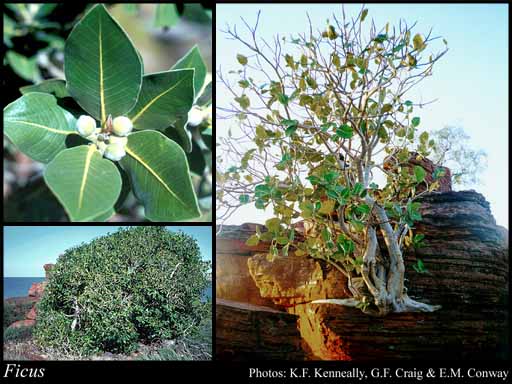- Reference
- Sp.Pl. [Linnaeus] 2:1059 (1753)
- Name Status
- Current

Scientific Description
Common name. Fig. Family Moraceae.
Habit and leaf form. Trees, or shrubs, or lianas; evergreen, or deciduous; laticiferous; resinous, or not resinous. Perennial. Leaves cauline. Self supporting, or epiphytic, or climbing; root climbers (or epiphytic stranglers). Mesophytic. Heterophyllous, or not heterophyllous. Leaves medium-sized to large; alternate, or opposite, or whorled (or ‘indeterminate’); often distichous, or spiral; decussate; leathery, or ‘herbaceous’; usually petiolate, or subsessile; non-sheathing; simple; epulvinate. Leaf blades dissected (then palmately lobed), or entire; elliptic, or oblong, or rhombic, or ovate, or obovate, or orbicular; when dissected, pinnatifid; pinnately veined, or palmately veined; cross-venulate; cordate, or cuneate at the base, or rounded at the base. Leaves with stipules. Stipules interpetiolar, or intrapetiolar; free of one another (and paired), or concrescent (connate and amplexicaul at base); ochreate, or not ochreate; sometimes minute; often caducous, or persistent. Leaf blade margins crenate, or dentate. Leaves without a persistent basal meristem. Leaf anatomy. Hydathodes present, or absent. Hairs present, or absent. Stem anatomy. Secondary thickening developing from a conventional cambial ring. Roots. Aerial roots present, or absent.
Reproductive type, pollination. Fertile flowers functionally male and functionally female, or functionally male, or functionally female. Unisexual flowers present. Plants monoecious, or dioecious. Male flowers without pistillodes (usually), or with pistillodes (sometimes). Anemophilous, or entomophilous.
Inflorescence and flower features. Flowers aggregated in ‘inflorescences’; in spikes, in heads, and in umbels (etc.). The terminal inflorescence unit cymose. Inflorescences axillary; inflorescence cauliflorus or on underground stolons; with involucral bracts (enclosing orifice of receptacle); pseudanthial, or not pseudanthial. Flowers pedicellate, or sessile; bracteate (2–3 bracts subtending fig, sometimes with lateral bracts); small (reduced); regular; cyclic; enclosed in the succulent receptacle. Perianth sepaline; 1–8; 1 -whorled, or 2 -whorled; more or less joined. Calyx present; 1–5(–8); polysepalous, or gamosepalous (connate, entirely gamophyllous); entire, or lobed; if not entire, lobulate, or blunt-lobed; imbricate, or valvate; regular; persistent. Corolla absent. Fertile stamens present, or absent (female flowers). Androecium 1–8. Androecial members free of the perianth; all equal; free of one another, or coherent (filaments may be joined in lower part). Androecium exclusively of fertile stamens. Stamens 1–8; all more or less similar in shape; isomerous with the perianth, or reduced in number relative to the adjacent perianth; oppositisepalous; erect in bud. Anthers dehiscing via longitudinal slits (or crescent shaped slit); introrse; tetrasporangiate. Fertile gynoecium present, or absent (male flowers). Gynoecium 2 carpelled. The pistil 1 celled. Carpels reduced in number relative to the perianth. Gynoecium syncarpous; synovarious to synstylovarious; superior. Ovary unilocular; 1 locular; sessile, or stipitate. Gynoecium stylate. Styles 1, or 2; free to partially joined; sub- apical, or ‘gynobasic’. Stigmas 2. Placentation apical, or basal. Ovules in the single cavity 1; pendulous, or ascending; anatropous to campylotropous, or hemianatropous.
Fruit and seed features. Fruit fleshy, or non-fleshy; indehiscent; achene-like; enclosed in the fleshy receptacle (often, and the inflorescence axis often constituting a common fleshy receptacle), or without fleshy investment. Gynoecia of adjoining flowers combining to form a multiple fruit, or not forming a multiple fruit. The multiple fruits coalescing, or not coalescing. Dispersal unit the seed, or the fruit, or the inflorescence. Fruit 1 seeded. Seeds endospermic, or non-endospermic. Endosperm oily, or not oily. Cotyledons 1 (by suppression), or 2. Embryo straight, or curved.
Economic uses, etc. Economically important for figs.
Etymology. From the Latin ficus (fig tree).